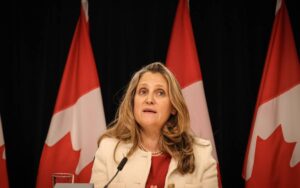
Do not be shocked if the ceiling is broken on price controls and a progressively minded Canadian government becomes tempted to experiment with the measures itself. Pictured: U.S. Vice President Kamala Harris. Photo Credit: Kamala Harris/X.
Last week, Democratic Presidential Candidate and U.S. Vice President Kamala Harris revealed various policies central to her economic platform. Overall, her proposals reflect a philosophy of broad market interventionism, much of which has been largely unheard of over the past several decades. The item that has created the most ruckus is her stated intention to work with Congress to pass legislation that will ban price-gouging in the grocery industry.
Liberal and conservative media sources alike were quick to express their skepticism and in many cases cynicism, about what Harris was suggesting. While we do not know for certain what tangible measures she will seek to employ, there is widespread concern that she may be considering price controls that will prohibit grocery stores from raising the prices of their products. If this is, indeed, a blueprint that Harris intends to pursue, residents of the United States, as well as Canada, need to understand the significance of this moment.
The last time in American history that price controls were enacted was by former president Richard Nixon, who used the approach multiple times, hoping that they would lower skyrocketing inflation. Ultimately, these actions were unsuccessful in their stated goal, as inflation continued throughout the 1970s. They also created product shortages and a corresponding unquenchable increase in demand, as businesses could not afford to continue offering many goods and services, without the ability to raise prices to cover the costs of production. As is often the case, similar measures were mimicked later in Canada, by Prime Minister Pierre Trudeau, with a similar effect.
Outside of the Nixon era, price controls have been seldom used in America. Former president Franklin Roosevelt most famously applied price controls to support the war economy during World War II. Even in this extreme moment of crisis, John Maynard Keynes, the father of Keynesian economics, who favoured various forms of intervention to maintain a well-adjusted economy in different contexts, was completely opposed to the measures. He argued passionately that they would be destructive to the free-market forces that are necessary for an economy to function. Canada, for its part, has never utilized price controls during peacetime, with the sole exception of the first Trudeau era.
At this point, it should be no surprise, therefore, that price controls are an enormously unpopular policy and have a horrendous reputation for failure. Only in the world’s socialist nations have price controls been applied on a broad level. So, what is going on, now, and what can be expected going forward?
The most likely scenario, at least many of us would like to think, is that Harris does not intend to utilize price controls. After all, many less extreme measures are available to fight price gouging, including raising interest rates, encouraging efficient supply chain management, and breaking up corporate monopolies. In any event, we can be encouraged that the American media has expressed great opposition to the idea from the get-go.
In the hypothetical scenario where a future President Harris does enact price controls, however, it will spell trouble for Canada. Since the United States is our largest trading partner, it is impossible for any fallout from failed American price control measures to not have a direct impact on our economy. Simply put, if their shelves become absent of certain consumer products, expect ours to be as well. Secondly, even with an unfavourable exchange rate, border communities could find themselves overwhelmed, and local businesses at a disadvantage, if Canadians decide to take advantage of the artificially lower prices of American goods. Finally, Canada usually adapts to the macroeconomic approach utilized by the United States, notwithstanding whether it is prudent to do so. With this reality in mind, do not be shocked if the ceiling is broken on price controls and a progressively minded Canadian government becomes tempted to experiment with the measures itself, just like half a century ago. Oh, the fun times in which we live.
Many of these things would have been largely unimaginable just a few short years (maybe even months) ago. Perhaps none of it will come to pass. However, while the historical record on price controls should speak for itself, the people often have a short memory.

Nick Redekop completed his Honours Bachelor of Arts Degree in Labour Studies at Brock University. He has previously served in municipal and federal politics. In his free time, Nick enjoys following sports, taking part in outdoor activities, and reading biographies. Nick resides in Niagara Falls




















